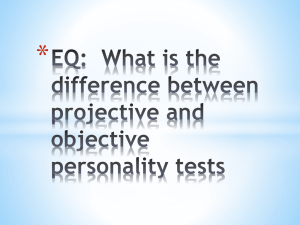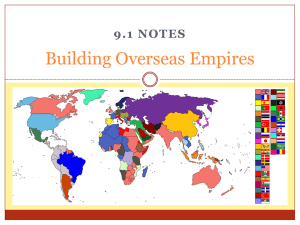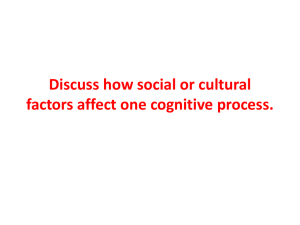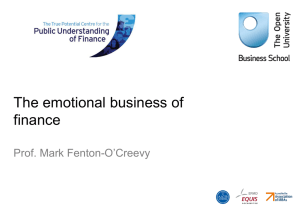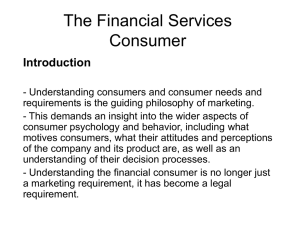CONSUMER MOTIVATION
advertisement
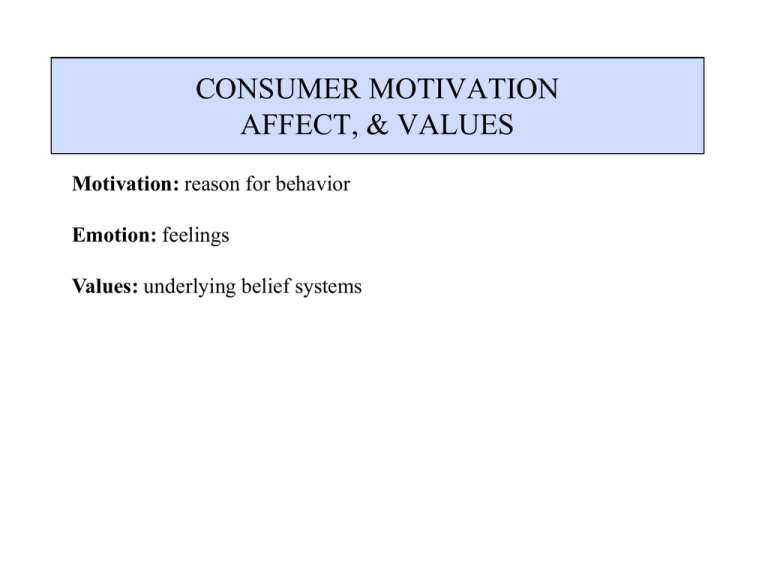
CONSUMER MOTIVATION AFFECT, & VALUES Motivation: reason for behavior Emotion: feelings Values: underlying belief systems Purchasing a golden retriever puppy? What are the various motives that people might have for purchasing this product? How do motives differ if the consumer is: 1) Father or mother of a family of two children, both under 6 years of age 2) A 20 year old single man or woman who is very independent and outdoor oriented 3) An older couple, retired, with children or grandchildren living near them Explore Your Motivation?? What motivates your consumption behavior? Think about 2 or 3 products/services you consumed this past weekend – what and why did you purchase/consume? Consumer Motivation Motivation: It is the reason for behavior! • an unobservable inner force that stimulates and compels a behavioral response and provides specific direction to that response. Goal: consumer’s desired end state Drive: degree of consumer arousal Want: manifestation of consumer need Three Types of Motivational Conflicts • Two desirable alternatives • Cognitive dissonance • Positive & negative aspects of desired product • Guilt of desire occurs • Facing a choice with two undesirable alternatives Classifying Consumer Needs: Types of Needs Summary of Psychological Motives Relevant to Marketing: Opponent-Process Theory Optimum Stimulation Levels Hedonic Experiences Risk: Seek or Avoid Attribute Causality Opponent Process Theory • A stimulus eliciting an immediate positive or negative emotion is followed by a feeling opposite to that initial emotion Optimum Stimulation Theory • Desire to maintain an optimal level of stimulation motivates action Hedonic Experiences • Consumption of products/services designed to create fantasies, enhance sensory stimulation, or elicit emotional reactions • Related to optimum stimulation levels Maintain Behavioral Freedom Motivation to Maintain Behavioral Freedom • People want to maintain a sense of freedom Psychological Reactance • negative motivational state that results when a person’s behavioral freedom has been threatened Two types of threats can lead to reactance: a) Social threats involving external pressure from other people to induce a consumer to do something – Scarcity appeals: “limited time offer, limited supply – Pushy salespeople b) Impersonal threats are barriers that restrict the ability to buy a particular product or service – Shortage of a product due to the possibility that someone else will buy it – Potential rise in the price of a product causes a desire to buy now Avoid or Seek Risk Perceived Risk – consumer’s perception of the overall negativity of a course of action - consists of negative outcomes and probability of these outcomes occurring Risks include: - financial - physical - performance - psychological - social - time - opportunity Motivation to Attribute Causality People seek out reasons to explain why things turn out as they do Negative Product or Service Experiences Was the cause internal or external? Your fault or the company’s? BIRGing and CORFing - Attributions towards sports teams Maslow’s Hierarchy of Needs – Marketing Strategies Physiological? • Health foods, medicines, sports drinks, exercise equipment Safety? • smoke detectors, preventive medicines, insurance, retirement investments Belongingness? • Food, entertainment, clothing Esteem? • Clothing, furniture, liquor, hobbies, cars Self-Actualization? • Education, hobbies, sports, gourmet foods, museums Motivation Theory and Marketing Strategy Consumers do not buy products; instead they buy motive satisfaction or problem solutions. Managers must discover the motives that their product and brands can satisfy and develop marketing mixes around these motives. Who purchases these products and what are the motives for purchasing: - Imported Beer: Beck’s, Heineken - Spaghetti Sauce: Classico, Newman’s Own Motivation Theory and Marketing Strategy Consumed by confident, upscale, professional men Desire for individuality Desire for status Consumed by upscale, sophisticated adults Motivated by indulgence and romance Motivated by ambition and individuality Motivation Theory and Marketing Strategy Discovering Purchase Motives Manifest motives are motives that are known and freely admitted. Consumers don’t always readily admit their motives Latent motives are either unknown to the consumer or are such that he/she is reluctant to admit them. Motivation Theory and Marketing Strategy Manifest motives? Latent motives? Manifest motives? Latent motives? Motivation, Emotion & Marketing Research The Selling of Science • What do you think of the emotion research techniques used at the beginning of the video? • Motivational research using projective techniques? – Credible and valid results? • How does Clotaire Rapaille feel about manifest motives? • What does Clotaire Rapaille refer to as latent motives? • Identify manifest and latent motives Consumer Involvement What are some examples of products that you are attached to? Not at all attached to? Involvement: perceived relevance of an object based on one’s needs, values, and interests Level of Involvement: – Inertia: consumption at the low end of involvement to – Cult product: command fierce consumer loyalty, devotion, and even worship by consumers who are highly involved Product vs. Situational Involvement Identify emotions List all the emotions you can think of If you’re a marketer, think about where is your emotional starting point? – How do consumers currently feel about your product? Brand? – How do you want them to feel? What are Emotions? How are they related to Consumer Behavior? Definition: • • Emotion is the identifiable specific feeling, and affect is the liking/disliking aspect of the specific feeling. Emotions are strong, relatively uncontrolled feelings that affect our behavior Emotion is sometimes the prime determinant of behavior Emotion influences: 1. The experiential nature of consumption 2. Attitude formation 3. Information processing 4. Postpurchase processes 5. Communication processes Emotions and Consumer Behavior What is your emotional reaction to the following products and brands? Emotion and Decision Making • Do consumers always make decisions based on rational facts? – Traditional consumer behavior research has emphasized a problem-solving approach • Emphasis is on cognitive reasoning, attribute expectations and goals • Consumers’ affective reactions to information (product attributes, sales pitch, ads) impacts their judgments, decisions, and purchase choices Affect as Information • Information becomes “marked” with affective meaning What do you see when you look at … – positive feelings draws us toward the option (approach behavior) – negative feelings draws us away from an option (avoidance behavior) • Affect Heuristic: The immediate affective reaction one experiences in response to an object, person or idea – Affect serves as a cue for many important judgments Affect as Common Currency: Comparing apples to oranges Should we remodel the kitchen … or, should we go to … Emotion and Marketing Strategy Marketers have always used emotions to guide the following on an intuitive level: • product positioning • sales presentations, and • advertising However, deliberate, systematic study of the relevance of emotions in marketing strategy is relatively new. Pop Quiz #1 1. First and Last name 2. Name the topics in the two current event presentations today. 3. What do BIRGing and CORFing stand for? 4. Explain the code on cheese in America. 5. What 3 emotions are you currently feeling? Emotions and Advertising Let’s go back to perception for a minute… Emotional content in ads can enhance attention, attraction, and maintenance capabilities. Emotional messages may be processed more thoroughly due to their enhanced level of arousal. Emotional ads may enhance liking of the ad itself. Repeated exposure to positive-emotion-eliciting ads may increase brand preference through classical conditioning. Emotions and Branding What is the motivation behind consumer attachment to brands? Why is emotional branding so important? What constitutes a great brand concept today? • Examples? Emotions and Branding A great brand concept can change a companies entire future. Biggest misconception in branding is the belief that branding is about market share when it is really about “mind and emotions share” What constitutes a great brand concept today? Engages consumers on the level of senses and emotions Comes to life for people and forges a deeper, lasting connection Understanding people’s emotional needs and desires is key to success. Values • Value: a belief that some condition is preferable to its opposite (e.g., youth) • Core values: values shared within a culture – e.g., honesty, cleanliness, independence, politeness, ambitious, helpful, respect, etc. What do you think are the three to five core values that best describe Americans today? Summary of American Core Values Value General Features Relevance to CB Achievement/Success Hard work is good, success flows from it Acts as justification of acquisition of goods Efficiency/Practicality Keeping busy is healthy and natural Stimulates interest in products that are timesavers and enhance leisure time Material Comfort “The Good Life” Fosters acceptance of luxury products that make life more comfortable and enjoyable Individualism Being oneself Stimulates acceptance of customized product that enable consumers to express their personality Freedom Freedom of choice Fosters interest in wide product lines and differentiated products Summary of American Core Values Value General Features Relevance to CB External Conformity Uniformity of observable behavior Interest in products that are used or owned by others in the same social group Humanitarianism Caring for others, particularly the underdog Patronage of firms that compete with market leaders Youthfulness A state of mind that stresses being “young at heart” and having a youthful appearance Acceptance of products that provide the illusion of maintaining or fostering youthfulness Fitness and Health Caring about one’s body, including the desire to be physically fit and healthy Acceptance of food, products, activities, and equipment perceived to maintain or increase physical fitness Sustainability: New Core Value? • Conscientious consumerism: consumer’s focus on personal health merging with a growing interest in global health • Consumers who: – Worry about the environment – Want products to be produced in a sustainable way – Spend money to advance what they see as their personal development and potential Materialism • Materialism: the importance people attach to worldly possessions • “The good life”...“He who dies with the most toys, wins” • Materialists: value possessions for their own status and appearance • Non-materialists: value possessions that connect them to other people or provide them with pleasure in using them
